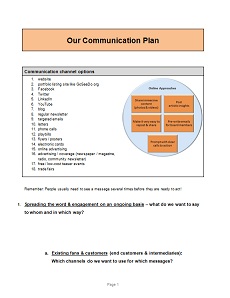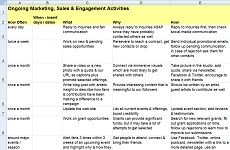How do you best communicate your messages?
Your marketing and sales goals should drive your communication plan – a plan for who you want to contact, what you want to say, and how you want to contact them. Based on that plan, draw up a schedule of ongoing marketing, sales and engagement activities that put your plan into practice.
Our templates and tips for effective online communication will get you off to a flying start! Any effort that you invest now will pay off quickly through more targeted and effective communication.

click to download the template

click to download the template
You need to have a general communication plan for spreading the word about your art making on an ongoing basis in order to
keep your fan base, customers, donors, advisory board and board members engaged over time. Your goal should be to create more productive relations with these different groups, so that they know what your offerings and projects are and want to share your messages across their own networks.
In addition, you should plan for some highly results-focused communication activities for specific events and programs, like your season and other main events or your year-end fundraising efforts.
Keep in mind that recipients usually need to see your message several times before they are ready to act. Remember to work out your resource requirements, so that you will actually be able to implement your communication plan.
 The 3 Best Communication Channels for Artists
The 3 Best Communication Channels for Artists
The following communication approaches offer the best cost – benefit ratio for individual artists and small arts organizations:
-
Online presence and ongoing engagement efforts (your website, a booking site like GoSeeDo.org, Facebook, Twitter, LinkedIn, YouTube, your blog)
Online communications channels are efficient, cheap, and immediate, making social media, networking tools, email and your website great places to start. In addition, online tools are an effective means of spreading your marketing messages efficiently across your and your connections’ networks, multiplying your reach.
LinkedIn is not a tool that is commonly used within the artist community, but key supporters, like your board members and major donors, will have built up extensive networks there from which you can benefit.
Make sure that you put the relevant links in your email signature block – if you are emailing a lot of people, you can extend your visibility beyond your standard mailing list via your signature.
-
Direct marketing and sales (emails, newsletters, mailings, phone calls)
Your direct marketing communication selects recipients based on relevant individual data, and targets them with appropriate messages to increase your sales and donations. Use of these tools relies to a large extent on your current contact list. Encouraging new people to join your mailing list, therefore needs to be one of your key marketing objectives.
In addition, you should identify new prospects by asking your existing connections for the details of other contacts who might be interested in your work, and by doing internet searches, e.g. for presenters.
-
Programs and playbills that include a call to action
Programs, playbills and other leaflets can be made more powerful by designing them with a clear goal in mind. Your focus should be on inviting more connections with your patrons and promoting further offerings. Add an engaging photo, the URL of your website or Facebook page and, most importantly, a specific call to action like “Join us at our next events”, “Book us for a house concert”, “Be a part of project xxx”, “Support our work”. You can also use a playbill to grow your contact list by asking people to send you an email or SMS (all consumers know how to send text messages) if they would like to receive exclusive content, like access to a video of the performance.
It is important to remember that each communication needs to be driven by a specific objective. This objective should be encapsulated in a clear call to action that tells your readers what you would like them to do next. Your messages may therefore need to make a distinction between communication for existing fans and customers, and reaching out to new potential patrons. At the same time, your communication needs to highlight your uniqueness with a consistent message and common overall style.
Related pages:
> How To Spread The Word Across Social Networks
> 12 Must-Dos For Your Artist Website
> How To Write A Simple Marketing Plan
> How To Write Compelling Documents
> Persuasion Tactics Artists Need To Know
Table of Contents


